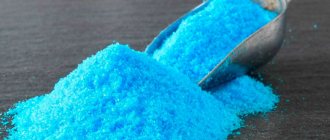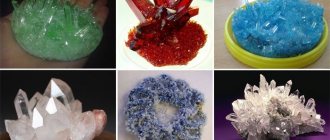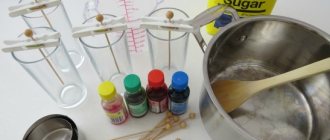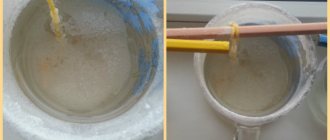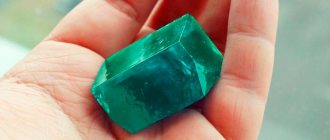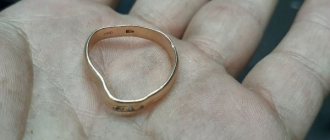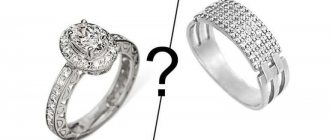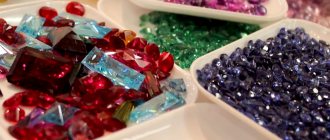Features of artificial stones
Of course, artificial crystals differ from real ones, and any jeweler will see the difference.
Artificial stones are in many ways not inferior to real ones, and sometimes even surpass them in size and other characteristics. Other properties also play an important role:
- shade;
- fragility;
- reflectivity;
- shape of edges;
- weight.
And in the case of synthetic gemstones, many of these characteristics can be easily controlled and changed at will. At the same time, the production of artificial crystals requires less effort and financial costs. And most importantly, creating synthetic stones at home is possible without complex equipment and chemical laboratories, and with them if you need a high return on investment.
Informational portal
It is not known exactly whether Auguste Verneuil knew at least in general terms about the essence of the method for obtaining “Geneva rubies,” but he was aware that Marc Gaudin in France had already produced ruby crystals using an oxygen-hydrogen torch. In 1869, Gaudin presented to the Academy of Sciences in Paris a small collection of corundum-based gemstones that were produced using his oxygen-hydrogen “chalumeau” [5]. This term was later used by Verneuil to refer to his burner. Gaudin's collection included blue sapphire, emerald, topaz, transparent diamond and peridot. To make the alumina powder more free-flowing, Godin considered it necessary to add silica SiO2 to it in fairly significant proportions, but since silica promotes the formation of glass and complicates the crystallization of the melt, he was afraid that the products of its synthesis would be represented by glasses. At that time, the equipment to distinguish glass from crystals was not advanced enough, so it is not certain whether Godin actually received sapphire crystals.
Verneuil concentrates his efforts on improving the method
In 1891, he made such significant progress in growing crystals by melting in a flame that he deposited an article on the details of his new apparatus and methodology in the Academy of Sciences. In this
At the stage of his work, apparently, the main goal was achieved - obtaining fairly large crystals, but they were worried about their cracking. This problem was soon solved by reducing the contact area between the crystal and the crystal carrier, which was described in the second article deposited at the Paris Academy of Sciences. The contents of both articles were not known until 1910, when they were disclosed in Verneuil's application [6].
Crystals grown using the Verneuil method are known as Boules
(bulges), apparently due to the fact that initially they had an approximately round shape. (The term "boule" was widely used to describe a game popular in France, in which heavy balls with a diameter of about 10 cm are tried to roll as close to the Goal as possible.) This term, coined by Gaudin and used by Verneuil, has now become common in the vocabulary of crystal growers and gemologists, even though the crystals currently grown are cylindrical in shape.
In 1900 Assistant
Verneuil Marc Pacquier demonstrates rubies
at the World Exhibition in
Paris.
A report on the stones was written by gemologist I. Friedlander, who came to the conclusion
that
the Rubies were obtained using
a new method, and not using the Genevan technology. Rubies were in great demand at the Paris Exhibition, although the details of the process were not revealed until 1902.[7]
Beginning his first written report, which was published two years later, Verneuil notes that Gaudin used too high temperatures and therefore obtained opaque crystals. Verneuil's new idea was to use a vertical burner, feeding alumina powder into the flame through a stream of oxygen. The powder is shaken in a gas stream under the action of an electrically driven vibrator. The use of a gas-tight rubber seal allows the shocks of the vibrator to be transmitted to the vessel containing the alumina powder without leaking oxygen. IN
A ceramic pin is placed in the cold part of the flame, on which drops of liquid alumina are collected when the powder melts and spills through the hot zone of the flame. The flame is surrounded by a ceramic muffle, which acts as an insulator and protects the growing boule from “drafts”. This muffle is equipped with a viewing window, which in the original Verneuil apparatus was sealed with mica. Excessive heating of the upper part of the device due to the heat flow from the hot zone is prevented by the use of water cooling.
In the initial stage of boule growth, the powder, falling on the pin, hardens and forms a cone of relatively low-density material. Subsequently, the cone is moved into the hot zone of the flame, where its top begins to melt. At this moment, several crystals are formed, but one of them is oriented in the direction of the highest growth rate. It suppresses the growth of other crystals and serves as a seed for the developing boule. During the early growth stage, operator skill is extremely important as adjustments to the flame temperature or powder feed rate may be necessary during crystal selection. After the predominant growth of one crystal begins in the central part, in order to increase the diameter of the boule, increase the feeding powder feed rate and gradually increase the flame temperature by adjusting the oxygen flow rate. The upper surface of the boule becomes rounded, and fresh portions of alumina are supplied to it in the form of falling drops of melt. Next, the stand with the pin is lowered at a speed corresponding to the growth rate of the boule.
The most important condition for growing high-quality crystals is a uniform supply of powder, so great effort is spent on preparing the feed material so that it has good flowability. If the powder is too coarse, the introduction of large cold particles can cause the thin molten layer to harden. Then many small crystals nucleate and the boule loses its single crystal structure. Using too fine a powder runs the risk of alumina evaporating in the flame. The optimal particle sizes lie in the submicron range (less than thousandths of a millimeter). The particles must have the correct shape, since only in this case they react equally to the influence of the vibrator. Verneuil obtained alumina from ammonium alum containing about 2.5% chromium impurities
2-1624
Alum. (This concentration of chromium ensured the production of red stones.) A powder of this composition was heated until alum decomposed and oxides formed, which were crushed and sifted through a wire sieve to select particles of the required size.
Verneuil grew boules weighing 2.5-3 g (12-15 carats) within 2 hours. The boules were round in shape, and some of them had a diameter of 5-6 mm. A more detailed description of the process with drawings of the apparatus is contained in the publication of 1904 [8]. This apparatus, together with the first crystals grown in this way, is now on display at the École des Arts et Métiers in Paris. Verneuil also worked on the problem of a vibrator, which shakes the powder into a stream of oxygen, and later replaced it with a hammer powered by a motor. This simple and reasonable device is used in most modern devices used for the production of commercial products.
From the descriptions published by Verneuil, it is clear that he was largely pleased with the quality of the rubies he obtained, which had a "delightful" fluorescence, the same hardness as natural rubies, and were suitable for high-quality polishing. However, he did not know that artificial rubies differ from natural stones by variations in color intensity and the presence of gas bubbles that occur when the oxygen content in the flame is not maintained at the required rather low level.
After the publication of 1904, Verneuil directed his efforts to obtain sapphire. At that time, it was not known what element determines the blue color of this stone, but he came in handy with the information that natural stones are given this color by the combined presence of iron and titanium oxides [9]. During this time, Verneuil worked as a consultant in New York and Paris. His sapphires contained the addition of 1.5% iron oxide and 0.5% titanium oxide instead of the chromium oxide used in rubies. The blue color of the crystals is due to a rather complex mechanism. Typically, the color of gemstones is related to the absorption of light of a characteristic wavelength by a particular element, especially the so-called transition elements such as iron, cobalt, nickel and chromium. If a certain band of colors is removed from the spectrum of white light, then the light entering the eye will be colored in the so-called Complementary color.
For example, rubies are red because the chromium in the corundum crystal lattice absorbs green light. For a sapphire to turn blue, yellow-orange light must be absorbed. This absorption occurs when an electron “jump” occurs within the crystal from iron atoms to titanium atoms. Therefore, to color a crystal blue, the combined presence of iron and titanium is required.
In 1911, patents were published on the growth of sapphire, the last of which contained information about the removal of bubble spots, crooked growth lines, and crystal cracking - a typical phenomenon for synthetic PO sapphires. In 1913, the annual production of artificial sapphire reached 6 million carats (1200 kg), and ruby - 10 million carats (2000 kg). Verneuil, thank you
Growing with Organic Salts
This method can be used when you are just starting to grow stones, and then move on to more complex ones.
This is the simplest and most affordable way to make gemstones. You will need:
- raw materials (alum from aluminum or potassium, table salt);
- a vessel in which the crystal will germinate, for example, a glass, jar or pan;
- filter (ordinary cotton wool or blotter will do);
- fishing line
The most popular material for growing gemstones is copper sulfate. Gemstones grow worse from standard salts, while copper sulfate is cheaper and more effective.
Other raw material options:
- bertholetic acid;
- ammonium chloride;
- sodium chloride;
- sodium sulfate.
Production consists of several steps:
- Preparation of the solution. First, pour a couple of tablespoons of salt into the container, then fill it with hot distilled water to the brim and stir until the crystals dissolve. You need to continue until the sediment begins to fall to the bottom.
- Composition filtration. If you use a dirty solution, the crystal will also be defective. Therefore, you need to infuse the liquid for 24 hours until the excess particles inside it settle to the bottom. They will also come in handy - the crystals themselves will grow on them.
- Tying the fishing line. The crystal will grow on the fishing line, as if crawling up it. You need to take a pencil, pen or other fastener, tie a fishing line to it and hang it over the vessel with the solution. It must be completely immersed in the composition. When the water evaporates, only a solid substance (vitriol crystals) remains, which will settle on the fishing line.
- Add the solution for two weeks. Over the next fourteen days, the saturated composition must be added to the container. If this is not done, the water will quickly evaporate, and the crystal will not have time to grow. The added solution should be at the same temperature as the composition in the glass.
- Pull out the crystal. After three months, the organic salt gemstone will be ready. It must be dried and then coated with colorless varnish (you can use regular nail polish). This is necessary to protect and retain shine.
Autoclave
Other gemstones, such as emerald, require a growing method that involves placing the raw material in water. To do this, you need to purchase a special autoclave device, as well as beryl, vanadium and chromium. The advantage of the device is that it can withstand high pressures and temperatures. The production process is as follows:
- Heating of the device.
- Place crushed beryl, water and additional elements in the hot compartment of the autoclave.
- When it reaches 600°C, the melted beryl moves to a cold compartment, where it settles to the bottom, forming an emerald.
Approximate production time is four weeks. And although the device and materials are quite expensive, the final profit will be very high.
Using an autoclave you can grow not only emeralds, but also other jewelry.
When experimenting, do not forget that you are working with chemicals that can be dangerous. Do not use medications without instructions or assistance from specialists. And of course, when working with chemical elements it is necessary to wear protection. The result is worth it - homemade crystals are not inferior in beauty to purchased ones.
Source
Auguste Verneuil apparatus
Most often, rubies and sapphires are grown using this device.
To grow rubies at home, you can use a device created by the French inventor Auguste Verneuil back in the 19th century. Thanks to this invention, it is possible to grow rubies of different shades (blue, transparent, green, yellow) in 2–3 hours. The device runs on electricity.
The device consists of the following parts:
- a funnel into which salts are placed;
- hole for oxygen penetration;
- burner;
- muffle (chamber for baking products);
- cathetometer;
- shaking device.
For production you will need chromium and aluminum oxides. Manufacturing process:
- Oxide salts are poured into a funnel.
- The device heats up in the burner.
- The salt is melting.
- Ruby crystals form at the bottom of the funnel. Under pressure it sags downwards, adjusting to the size of the stone.
The final cost of the crystal will be higher than the resources expended, so such a business can be considered profitable.
Growing ruby crystals at home using the Verneuil method
Author of the idea: Mikhail Babin E-mail Website: https://rubin-bmm.narod.ru
I have already published three of my ideas on this site (Stained glass from colored glass, Making mosaic panels and tables, Growing mosaic panels in an incubator). The new idea, which I called “Growing Ruby Crystals at Home,” was born similar to idea 1404 in the process of psychological counseling using the techniques I used to develop creative thinking. It was thanks to these techniques that this new idea was born in collaboration with my other now business partner. I will not go into detail about what problems a young man named Alexander came to me with (now it doesn’t matter), but the result of our joint work was the birth of this idea of a home business.
